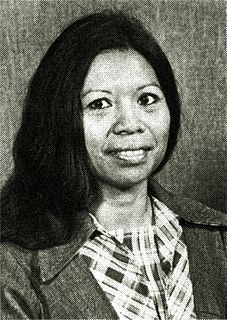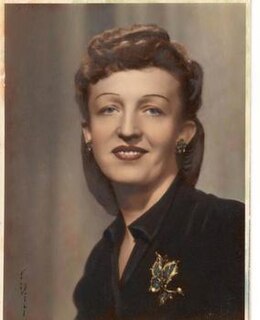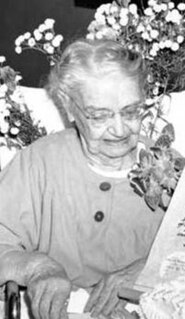Related Research Articles

Thelma Garcia Buchholdt was a Filipino American community activist, politician, historian, public speaker, cultural worker, and author. She was elected to the Alaska House of Representatives for four consecutive terms, from 1974 through 1982. She was the author of the book Filipinos in Alaska: 1788-1958, which is now in its third printing and is available through the Anchorage Museum at Rasmuson Center.

The Alaskan Engineering Commission (AEC) was a U.S. Federal agency, sometimes known by its initials or by alternate spelling Alaska Engineering Commission. It was created by the Alaska Railroad Act in 1914 by U.S. President Woodrow Wilson in order to arrange for the construction of a railway system in Alaska. William C. Edes was named chairman, chief engineer Colonel Frederick Mears. In 1915, the AEC became part of the U.S. Department of the Interior. In 1923, after the railroad began operation and construction was complete, it became the Alaska Railroad Commission, later renamed to The Alaska Railroad.
The Alaska Women's Hall of Fame (AWHF) recognizes women natives or residents of the U.S. state of Alaska for their significant achievements or statewide contributions. It was conceived by the board of directors of the Alaska Women's Network (AWN) in commemoration of the 50th anniversary of Alaska's statehood. The large inaugural class of fifty women were inducted weeks after that anniversary, on March 6, 2009, with subsequent classes inducted every year since. As of the class of 2015, 135 women and one organization, the Sisters of Providence, have been honored. The principal organizations involved with the AWHF are the Zonta Club of Anchorage, the YWCA, Alaska Women for Political Action, the Anchorage Women's Commission, the University of Alaska Anchorage, Alaska Women's Network and the ATHENA Society.

Irene Esther Ryan was an American geologist, aviator, and legislator during Alaska's history as both a United States territory and as a U.S. state. She was a member of the Alaska Territorial House of Representatives and of the Alaska State Senate. She was instrumental in the creation of the Alaska Oil and Gas Conservation Commission, which helped insure state revenue from oil and gas exploration done by outside entities.

Evangeline Atwood (1906–1987) was an American historian, activist, and philanthropist. She was the co-founder of numerous organizations in Alaska, including the Alaska Statehood Association, the Anchorage League of Voters, the Alaska World Affairs Council, Parent-Teacher Council of Anchorage, and the Cook Inlet Historical Society. In 2009, she was named to the Alaska Women's Hall of Fame. Her husband was Robert Atwood and was the co-owner, alongside him, of the Anchorage Times.

Orah Dee Clark (1875–1965) was an American educator. She was the first superintendent for the first school in Anchorage, Alaska. In 2009, she was named into the Alaska Women's Hall of Fame.
Carol Comeau is an American educator. She was inaugurated to the Alaska Women's Hall of Fame in 2009.
Dorothy Awes Haaland was an American lawyer and politician. She served in the final Alaska Territorial Legislature when Alaska was still the Territory of Alaska. In 2009, she was added to the Alaska Women's Hall of Fame. She was the first woman to be admitted to the Alaska Bar Association.
Lorene Harrison (1905-2005) was an American educator, singer, choir director, and milliner. In 2009, she was inaugurated into the Alaska Women's Hall of Fame.
Katharine Seymour Day was an American preservationist from Hartford, Connecticut. She worked as a member of the Hartford City Planning Commission to preserve historic homes in Connecticut and helped establish the Children’s Museum of Hartford and the home of Mark Twain as a memorial. She served as president of the Mark Twain Library and Memorial Commission. She was inducted into the Connecticut Women's Hall of Fame in 1994. The Katharine Seymour Day House has been preserved as part of the Harriet Beecher Stowe House Museum.
Daphne Elizabeth Brown (1948–2011) was an American architect who was posthumously inducted into the Alaska Women's Hall of Fame and awarded the Kumin Award from the American Institute of Architects, the highest recognition for architectural achievement in Alaska.

Colonel Frederick Mears was an American military officer in the US Army and railroad engineer and executive. He was the son of a career army officer and his brother Major Edward C. Mears was also in the US army. Mears was principal engineer of the Alaska Railroad. Mears took advanced engineering courses at the Infantry and Cavalry School, located at Fort Leavenworth, Kansas and became a cavalry officer in the US Army.

Alice E. Brown was a member of the Kenaitze Tribe of Dena'ina peoples, who worked for Native Alaskan rights. She was the only woman to serve on the original Alaska Federation of Natives' Board of Directors and pressed for passage of the Alaska Native Claims Settlement Act. Brown was posthumously inducted into the Alaska Women's Hall of Fame in 2010.

Olga Katherine Torkelsen Hurley was the Secretary to Alaska Territorial Governor Ernest Gruening from 1944 until his departure from office in 1953. She was Chief Clerk to the Alaska Constitutional Convention in 1955–56 and the secretary to the State Senate for five terms. In 1984, she was elected to seat 16-A in the Alaska house, serving until January 1987.
Arne Beltz was an American nurse best known for her work in public health. The Arne Beltz Building, which houses the Anchorage, Alaska Department of Health and Human Services, was named in her honor in 1990. In 2013, Beltz was inducted into the Alaska Women's Hall of Fame.
Daisy Lee Bitter is an American science educator. She was named to the Alaska Women's Hall of Fame in 2015.
Lidia Lippi Selkregg was an Italian geologist and professor of regional planning at the University of Alaska Anchorage. In the days following the 1964 Alaska earthquake, Selkregg helped organize a group of local geologists to gather important data about earthquake damage to inform future recommendations about building stability. She also helped promote earthquake safety, land preservation, and economic development in the Anchorage area.
L. Arlene “Buddy” Clay (1912–2016) was a symphony performer, volunteer plane spotter, and Alaskan judge.

Amache Ochinee Prowers, also known as Walking Woman (1846–1905), was a Native American activist, advocate, cattle rancher, and operator of a store on the Santa Fe Trail. Her father was a Cheyenne peace chief who was killed during the Sand Creek massacre on November 29, 1864, after which she became a mediator between Colorado territorial settlers, Mexicans, and Native Americans during the 1860s and 1870s. She was inducted into the Colorado Women's Hall of Fame in 2018.
References
- 1 2 3 4 "'Kit' Crittenden, who helped beautify city, dies at 88". Alaska Dispatch News. February 15, 2010.
- 1 2 "Katharine "Kit" Crittenden". Alaska Women's Hall of Fame.